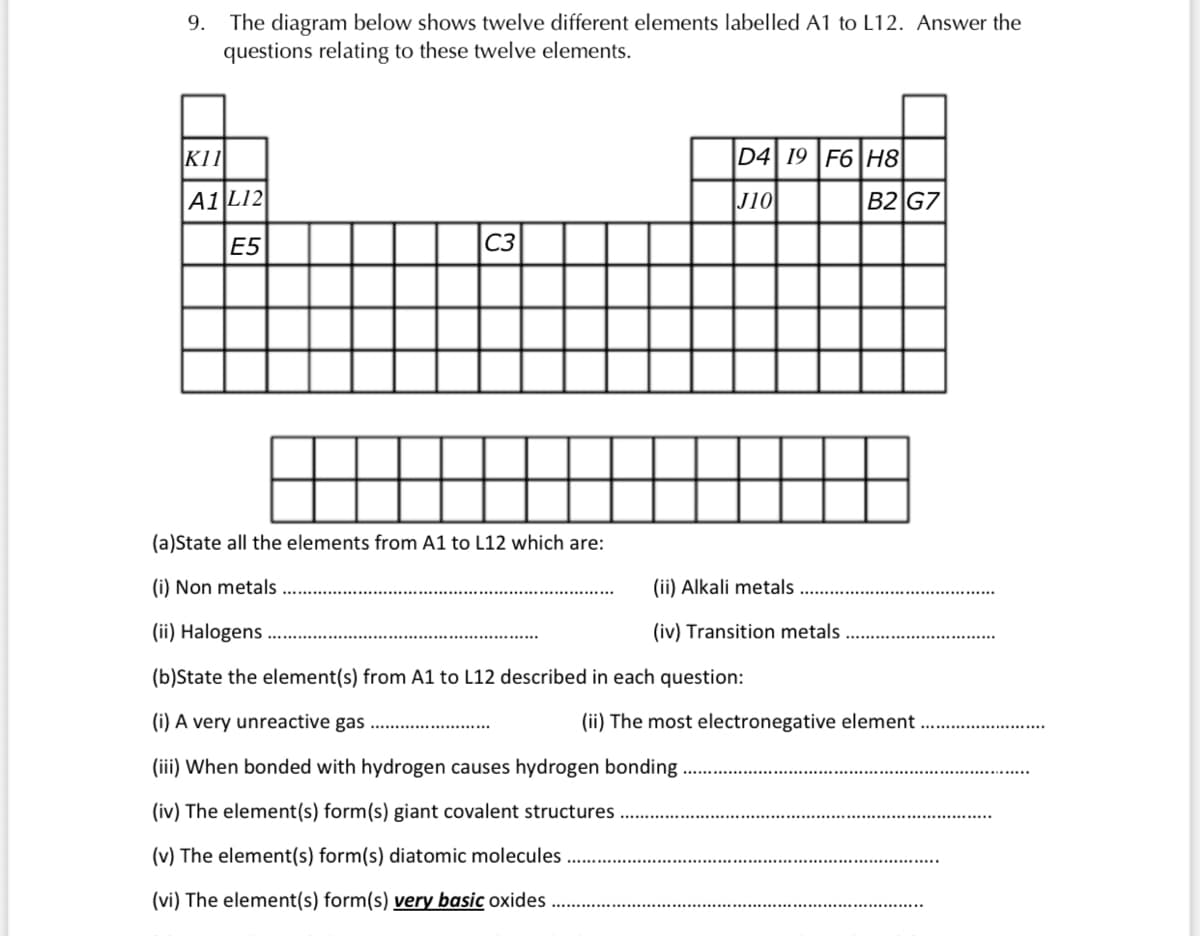The diagram below shows twelve different elements labelled A1 to L12. Answer the questions relating to these twelve elements. 9. KII D4 19 F6 H8 A1 L12 J10 B2 G7 E5 C3 (a)State all the elements from A1 to L12 which are: (i) Non metals (ii) Alkali metals (ii) Halogens . (iv) Transition metals (b)State the element(s) from A1 to L12 described in each question: (i) A very unreactive gas (ii) The most electronegative element (iii) When bonded with hydrogen causes hydrogen bonding (iv) The element(s) form(s) giant covalent structures (v) The element(s) form(s) diatomic molecules (vi) The element(s) form(s) very basic oxides.
The diagram below shows twelve different elements labelled A1 to L12. Answer the questions relating to these twelve elements. 9. KII D4 19 F6 H8 A1 L12 J10 B2 G7 E5 C3 (a)State all the elements from A1 to L12 which are: (i) Non metals (ii) Alkali metals (ii) Halogens . (iv) Transition metals (b)State the element(s) from A1 to L12 described in each question: (i) A very unreactive gas (ii) The most electronegative element (iii) When bonded with hydrogen causes hydrogen bonding (iv) The element(s) form(s) giant covalent structures (v) The element(s) form(s) diatomic molecules (vi) The element(s) form(s) very basic oxides.
Chemistry for Engineering Students
4th Edition
ISBN:9781337398909
Author:Lawrence S. Brown, Tom Holme
Publisher:Lawrence S. Brown, Tom Holme
Chapter2: Atoms And Molecules
Section: Chapter Questions
Problem 2.84PAE: 2.84 Early attempts to arrange the elements often focused on atomic weight. Mendeleev considered a...
Related questions
Question
Answer the following

Transcribed Image Text:9.
The diagram below shows twelve different elements labelled A1 to L12. Answer the
questions relating to these twelve elements.
K11
D4 19 F6|H8
A1L12
J10
B2 G7
E5
C3
(a)State all the elements from A1 to L12 which are:
(i) Non metals
(ii) Alkali metals
(ii) Halogens .
(iv) Transition metals
(b)State the element(s) from A1 to L12 described in each question:
(i) A very unreactive gas
(ii) The most electronegative element
(iii) When bonded with hydrogen causes hydrogen bonding
(iv) The element(s) form(s) giant covalent structures
(v) The element(s) form(s) diatomic molecules
(vi) The element(s) form(s) very basic oxides
Expert Solution
This question has been solved!
Explore an expertly crafted, step-by-step solution for a thorough understanding of key concepts.
This is a popular solution!
Trending now
This is a popular solution!
Step by step
Solved in 3 steps

Knowledge Booster
Learn more about
Need a deep-dive on the concept behind this application? Look no further. Learn more about this topic, chemistry and related others by exploring similar questions and additional content below.Recommended textbooks for you

Chemistry for Engineering Students
Chemistry
ISBN:
9781337398909
Author:
Lawrence S. Brown, Tom Holme
Publisher:
Cengage Learning

Chemistry & Chemical Reactivity
Chemistry
ISBN:
9781337399074
Author:
John C. Kotz, Paul M. Treichel, John Townsend, David Treichel
Publisher:
Cengage Learning

Chemistry & Chemical Reactivity
Chemistry
ISBN:
9781133949640
Author:
John C. Kotz, Paul M. Treichel, John Townsend, David Treichel
Publisher:
Cengage Learning

Chemistry for Engineering Students
Chemistry
ISBN:
9781337398909
Author:
Lawrence S. Brown, Tom Holme
Publisher:
Cengage Learning

Chemistry & Chemical Reactivity
Chemistry
ISBN:
9781337399074
Author:
John C. Kotz, Paul M. Treichel, John Townsend, David Treichel
Publisher:
Cengage Learning

Chemistry & Chemical Reactivity
Chemistry
ISBN:
9781133949640
Author:
John C. Kotz, Paul M. Treichel, John Townsend, David Treichel
Publisher:
Cengage Learning

Introduction to General, Organic and Biochemistry
Chemistry
ISBN:
9781285869759
Author:
Frederick A. Bettelheim, William H. Brown, Mary K. Campbell, Shawn O. Farrell, Omar Torres
Publisher:
Cengage Learning

General Chemistry - Standalone book (MindTap Cour…
Chemistry
ISBN:
9781305580343
Author:
Steven D. Gammon, Ebbing, Darrell Ebbing, Steven D., Darrell; Gammon, Darrell Ebbing; Steven D. Gammon, Darrell D.; Gammon, Ebbing; Steven D. Gammon; Darrell
Publisher:
Cengage Learning

Introductory Chemistry: An Active Learning Approa…
Chemistry
ISBN:
9781305079250
Author:
Mark S. Cracolice, Ed Peters
Publisher:
Cengage Learning